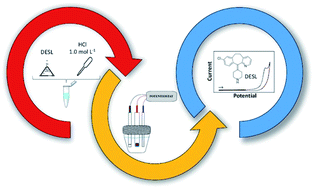A differential pulse voltammetric method for submicromolar determination of antihistamine drug desloratadine using an unmodified boron-doped diamond electrode
Abstract
A sensitive electrochemical method was developed for the determination of desloratadine (DESL) in different samples employing differential pulse voltammetry (DPV) and an unmodified boron-doped diamond electrode. Using cyclic voltammetry, an irreversible, well-defined and diffusion-controlled oxidation peak was observed at 1.55 V in phosphate buffer solution (pH 4.0). Using DPV under optimized operating conditions, it was found that the peak current was linear within the DESL concentration range of 0.099–6.3 μmol L−1, with a limit of detection of 41.0 ηmol L−1. This procedure was successfully applied to assay drugs in tablets and syrup and obtained statistically concordant results with those obtained by spectrophotometry. Applicability was also tested in human urine and tap water samples and obtained excellent recovery percentages.



 Please wait while we load your content...
Please wait while we load your content...